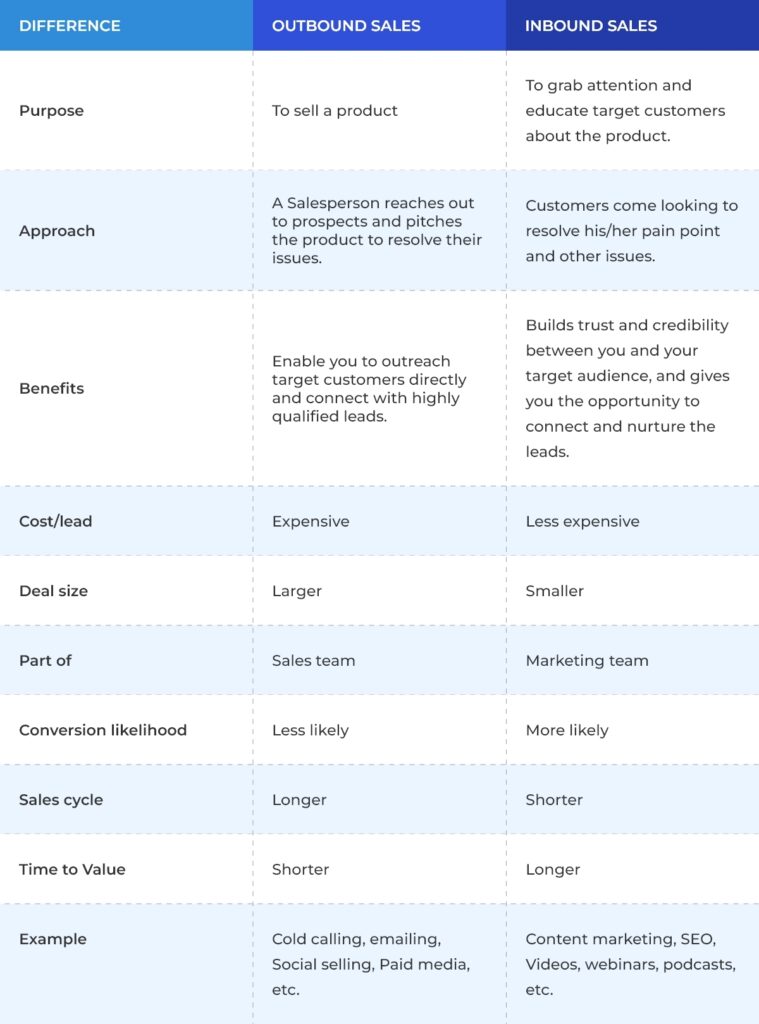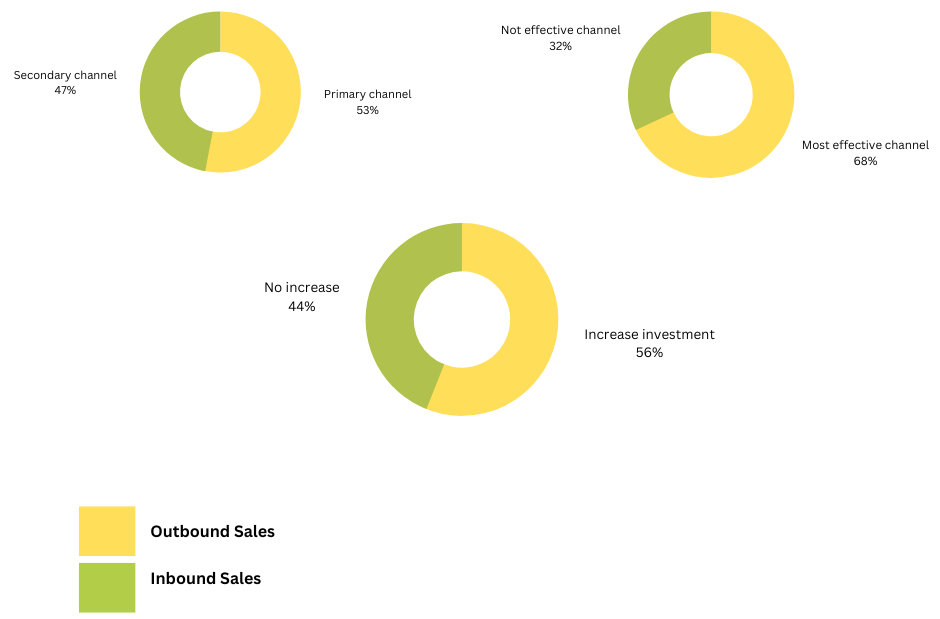For any B2B SaaS start-up, deciding on the right sales strategy for your company can be a complex task. Inbound vs outbound sales strategies are two popular options to consider.
Inbound sales is often cost-effective and easy to scale, while outbound sales is a powerful way to establish customer relationships and close deals.
Determining the most suitable approach for your business requires weighing the pros and cons of each sales technique. However, the best approach is often a combination of both inbound and outbound sales strategies.
To make an informed decision, it’s important to understand the differences between inbound and outbound sales.
What is Inbound and Outbound sales?
Inbound sales is the process of attracting and engaging customers through valuable content that helps them solve their problems.
The inbound approach seeks to attract customers through various channels such as blogs, social media, and search engines. Inbound sales focus on building relationships with potential customers and nurturing them through the sales funnel.
Outbound Sales refer to reaching out to potential customers directly, typically through phone calls, email, or direct mail. Outbound sales are a more traditional approach that focuses on actively pursuing customers and closing deals.
Best Inbound and Outbound Sales Strategies
Strategies for Effective Inbound Sales:
- Create high-quality content: Valuable content is the foundation of successful inbound sales. Content can take many forms, including blog posts, e-books, videos, and webinars.
- Optimize for search engines: By optimizing content for search engines, inbound sales teams can attract a larger audience to their website.
- Leverage social media: Social media is an excellent platform for sharing content and engaging with potential customers.
- Use lead magnets: Offering a free resource or valuable content in exchange for contact information is an effective way to generate leads.
Outbound Sales strategies
- Set up an outreach strategy: Outreaching prospects should not be a guessing game. Research them thoroughly and personalize the approach. This strategy will help the outbound sales teams increase their chances of success.
- Social selling: Giving more than you receive is the basis of social selling. Keeping this in mind, make a list of your best tips for your industry. Then, generate high-quality value-focused content that helps your audience.
- Leverage technology: Technology can be used to automate and streamline the outbound sales process, increasing efficiency and reducing costs.
- Use data to inform sales tactics: Data analytics can help sales teams identify the most promising prospects and tailor their approach accordingly.
- Focus on the benefits: Outbound sales teams should emphasize the benefits of their product or service, rather than simply pushing for a sale.
Extra resource: Why is Outbound Sales going to be an important strategy in 2023
Key points of differences- Inbound vs Outbound sales

Pros and Cons of Inbound and Outbound Sales
Inbound Sales
Pros
- Higher-quality leads – Inbound leads are often more qualified and have already expressed interest in the product or service.
- Lower cost per lead – Inbound marketing tactics such as content marketing and SEO can generate leads at a lower cost than outbound sales.
- Builds trust and credibility – Inbound sales allow for a more personalized and educational approach, which can help establish trust and credibility with potential customers.
Cons
- Longer sales cycle – The inbound approach requires time and effort to build relationships and trust, resulting in a longer sales cycle.
- Dependence on marketing efforts – Inbound sales rely heavily on marketing tactics, which can be unpredictable and require constant optimization.
- Limited control over lead volume – Inbound sales can generate varying levels of lead volume, making it difficult to plan and forecast future revenue.
Outbound Sales
Pros
- More control over lead generation – Outbound sales allow businesses to proactively target and reach out to potential customers.
- Faster sales cycle – Outbound sales can result in a faster sales cycle, as the sales process is initiated by the business rather than the customer.
- Scalability – Outbound sales tactics can be scaled quickly to generate more leads and revenue.
Cons
- Higher cost per lead – Outbound sales often require more resources and higher costs to generate leads compared to inbound sales.
- Lower conversion rates – Outbound sales can be seen as intrusive and may result in lower conversion rates compared to inbound sales.
- Can damage brand reputation – Poorly executed outbound sales tactics can damage a business’s reputation and make it more difficult to generate leads in the future.
Which Sales Approach Is Right for Your Business?
Factors to consider when deciding between inbound and outbound sales
When deciding between inbound and outbound sales, it’s important to consider the unique needs and goals of your business. Here are some factors to consider:
Business goals: What are your business goals and how do they align with each sales approach? Answer this question first!
If your goal is to build brand awareness and attract potential customers, inbound sales may be the best approach. If your goal is to close more deals quickly, outbound sales may be a better fit.
Target audience: Ask questions like-
- Who is your target audience and what are their preferences?
- Do they prefer to do their own research and find solutions, or do they prefer to be reached out to directly?
This can help determine whether inbound or outbound sales is a better fit.
Budget and resources: Consider your available budget and resources, including staff and technology. Inbound sales can often be less expensive, but it requires significant investment in marketing efforts.
Outbound sales require more resources and investment in lead generation and sales teams.
Sales cycle: The length of your sales cycle is a crucial parameter to consider before deciding on a strategy. Inbound sales require building relationships and trust, which can take longer, while outbound sales is more proactive and can close deals more quickly.
Examples of businesses that excel at outbound sales
According to a 2021 report by the SaaS Sales Pros, outbound sales continue to be an effective way for B2B SaaS companies to generate revenue. The report found that:
- 53% of B2B SaaS companies use outbound sales as their primary customer acquisition channel
- 68% of B2B SaaS companies said outbound sales was their most effective channel for closing deals and generating revenue
- 56% of B2B SaaS companies plan to increase their investment in outbound sales in the coming year
These numbers are shown in the graph below.

Let’s look at other statistics as well-
- Firms that don’t cold call experienced 42% less growth than those who used the tactic.
- According to Crunchbase, the top sellers on average dedicate 6 hours per week to researching their prospects.
- Outbound leads are 5x more likely to result in a sale than inbound leads (Insidesales.com).
- Another report by SalesHacker found that outbound sales and marketing efforts accounted for 70% of revenue generated by B2B SaaS companies.
Suggested Read: The Winning Script for your first cold call
These statistics suggest that outbound sales is a valuable tool for B2B SaaS startups to generate revenue.
However, it’s worth noting that the effectiveness of outbound sales can vary depending on the target market, the product or service being sold, and the specific tactics used.
Some of the B2B SaaS firms that excel at Outbound Sales-
- Salesforce
- ZoomInfo
- Gong
- Outreach
- Freshworks
Key takeaways
In conclusion, both inbound and outbound sales work, if you do them right. Which one to choose then? Well, it depends on the nature of your business and current requirements.
- Inbound sales, through content marketing, social media, and SEO, can generate leads and customers with little to no initial outreach required.
- Outbound sales, on the other hand, can provide a more targeted approach to reaching potential customers through email campaigns, cold calling, and direct mail.
- Companies that have excelled at outbound sales include industry leaders like Salesforce, HubSpot, and Gong. By combining technology, data-driven targeting, and personalized messaging, these companies have created successful outbound sales campaigns that have generated significant revenue.
Ultimately, the most effective sales strategies will depend on your business’s specific needs and goals. By understanding the differences and benefits of both inbound and outbound sales, you can create a customized approach that maximizes your potential for success.
